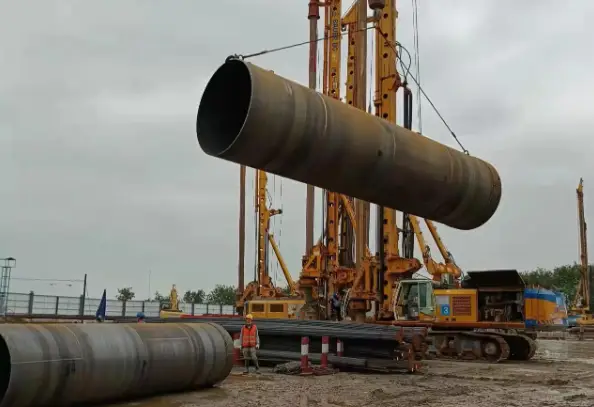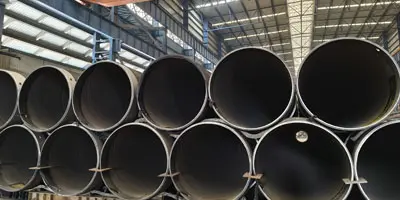Manufacturing Process of Welded Steel Pipe Piles: A Comprehensive Guide
Welded steel pipe piles are crucial components in construction, especially for supporting heavy loads in deep foundation systems. These piles provide stability for structures such as buildings, bridges, and piers. The manufacturing process of welded steel pipe piles involves a series of steps that ensure they are strong, durable, and capable of withstanding the stresses of construction. In this guide, we will explore the manufacturing process, types, and benefits of welded steel pipe piles.
What Are Welded Steel Pipe Piles?
Welded steel pipe piles are structural elements used to support and transfer loads to deeper, more stable soil layers. Made by welding steel plates together, these piles are shaped into cylindrical sections. The primary function of steel pipe piles is to anchor heavy structures into the ground, providing stability in various construction projects.
These piles come in various sizes and configurations, including H-piles, pipe piles, and sheet piles. The choice of pile type depends on factors such as the soil conditions, design loads, and construction methods. Welded steel pipe piles are commonly used in deep foundations and marine constructions due to their ability to carry heavy loads.
The welding process used to create steel pipe piles is critical to their strength. Common techniques include Electric Resistance Welding (ERW) and Submerged Arc Welding (SAW). ERW involves applying an electric current to heat and fuse steel plates, while SAW uses a flux to shield the weld from contaminants.
Specifications of Steel Pipe Piles
Steel pipe piles typically come in the following sizes:
Diameter Range: 325 mm to 2400 mm
Wall Thickness Range: 8 mm to 60 mm
Length Range: 6 meters to 12 meters
The steel pipe piles are fabricated using a continuous process, beginning with hot-rolled steel coils as raw materials. The steel is formed into pipes at ambient temperature using a spiral rolling method. These pipes are then welded using double-wire, double-side submerged arc welding, ensuring strong and durable joints.
Manufacturing Process of Welded Steel Pipe Piles
The manufacturing process of welded steel pipe piles involves several steps to ensure the quality, strength, and durability of the final product. These steps include material preparation, welding, testing, and inspection. Below is a breakdown of the typical process:
1. Material Selection and Preparation
The manufacturing process begins with selecting high-quality steel plates, which are cut to the required dimensions. These plates are then carefully inspected for defects and subjected to rigorous physical and chemical testing to ensure they meet the necessary standards.
Once the steel plates pass the inspection, they are prepared by trimming the edges, removing any rust, and cleaning the surface. This ensures the steel plates are ready for the welding process.
2. Forming the Steel Plates into a Pipe
Next, the steel plates are fed into a forming machine, which bends them into a cylindrical shape. This is done through a spiral rolling process, where the edges of the plates are shaped to form a continuous tube. The edges of the steel plates are then aligned and ready for welding.
3. Welding Process
The aligned edges of the formed steel plate are welded together using either Electric Resistance Welding (ERW ) or Submerged Arc Welding (SSAW ).
Electric Resistance Welding (ERW PIPE): In this method, an electric current is passed through the steel plates, causing them to heat up and fuse together. This creates a strong, seamless bond.
Submerged Arc Welding (SSAW PIPE): This technique involves using a flux to shield the weld from atmospheric contamination, ensuring a strong, high-quality bond.
These welding processes are automated and carefully controlled to ensure the welds are uniform and strong, providing maximum strength and durability to the welded steel pipe piles.
4. Inspection and Testing
After the welding process, the steel pipe piles undergo various quality control tests. These include non-destructive testing methods such as ultrasonic testing and X-ray inspection to detect any potential flaws in the welds.
5.Hydrostatic Testing
Additionally, each pile undergoes hydrostatic testing to ensure it can withstand high pressure. The hydrostatic test is performed by filling the pipe with water and subjecting it to pressure to check for leaks or weaknesses in the welds.
6.Final Inspection and Surface Treatment:
The steel pipes are cut into individual lengths using plasma cutting machines. After cutting, each batch of pipes undergoes initial inspections. These include checks on the mechanical properties of the welds, chemical composition, and surface quality. Non-destructive testing is also performed to verify the integrity of the pipe.
Once the welded steel pipe piles have passed the necessary inspections and tests, they are cut to the required length using a plasma cutting machine. After cutting, the ends of the pipes are mechanically processed to ensure they are perpendicular, with the correct bevel angle and smooth surface.
Types of Welded Steel Pipe Piles
Most welded steel pipes start as flat steel plates. Some start as hot rolled coils. Regardless, the process involves shaping the steel base material into the desired shape and size, either in a spiral weld or straight seam configuration. There are three main types of welded steel pipe, and they differ slightly in how they are produced and the end result they produce. Here are the three main types of welded steel pipe:Welded steel pipe piles come in several types, each designed for specific applications. The most common types include:
H-piles: These piles are shaped like the letter "H" and are commonly used in deep foundations for structural support.
Pipe piles: Made from cylindrical sections of welded steel pipes, these piles are versatile and suitable for both end-bearing and friction applications.
Sheet piles: These thin, flat steel sections are driven into the ground to create barriers or retaining walls.
ERW pipes are suitable for applications that require strength and efficiency but do not demand extremely high pressure resistance.
LSAW and DSAW pipes are ideal for high-pressure applications due to their robust welds and resistance to external and internal stresses.
Spiral welded pipes are often the best choice for projects requiring long, thick pipes, and they are typically more cost-effective than LSAW or DSAW.
The choice of pile type depends on several factors, such as the soil conditions, design loads, and project requirements. Each type of welded steel pipe pile offers distinct advantages and is suitable for specific applications.
Benefits of Welded Steel Pipe Piles
Welded steel pipe piles offer several benefits for construction projects, including:
High Load Capacity: These piles are capable of supporting heavy loads, making them ideal for large-scale structures.
Durability: Steel pipe piles are resistant to corrosion, ensuring they can withstand harsh environmental conditions.
Versatility: Available in various sizes and types, welded steel pipe piles can be customized to meet the specific requirements of each project.
Cost-Effectiveness: The efficient manufacturing process helps reduce the cost of production while maintaining high quality.

Conclusion
The manufacturing process of welded steel pipe piles involves several crucial steps to ensure the strength, durability, and quality of the final product. From material selection to welding, testing, and final processing, each stage is designed to meet the rigorous demands of modern construction. With their ability to support heavy loads, resistance to environmental factors, and versatile applications, welded steel pipe piles remain a fundamental component in construction and foundation work. Understanding their manufacturing process and types will help ensure the right pile is chosen for your next project.






 English
English Español
Español بالعربية
بالعربية











 Phone :
Phone :  Whatsapp :
Whatsapp :  Email :
Email : 


